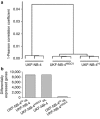Selection of a highly invasive neuroblastoma cell population through long-term human cytomegalovirus infection
- PMID: 23552602
- PMCID: PMC3412641
- DOI: 10.1038/oncsis.2012.10
Selection of a highly invasive neuroblastoma cell population through long-term human cytomegalovirus infection
Abstract
The human cytomegalovirus (HCMV) is suspected to increase tumour malignancy by infection of cancer and/or stroma cells (oncomodulation). So far, oncomodulatory mechanisms have been attributed to the presence of HCMV and direct action of its gene products on cancer cells. Here, we investigated whether the prolonged presence of HCMV can result in the irreversible selection of a cancer cell population with increased malignancy. The neuroblastoma cell line UKF-NB-4 was long-term (200 passages) infected with the HCMV strain Hi91 (UKF-NB-4(Hi)) before virus eradication using ganciclovir (UKF-NB-4(HiGCV)). Global gene expression profiling of UKF-NB-4, UKF-NB-4(Hi) and UKF-NB-4(HiGCV) cells and subsequent bioinformatic signal transduction pathway analysis revealed clear differences between UKF-NB-4 and UKF-NB-4(Hi), as well as between UKF-NB-4 and UKF-NB-4(HiGCV) cells, but only minor differences between UKF-NB-4(Hi) and UKF-NB-4(HiGCV) cells. Investigation of the expression of a subset of five genes in different chronically HCMV-infected cell lines before and after virus eradication suggested that long-term HCMV infection reproducibly causes specific changes. Array comparative genomic hybridisation showed virtually the same genomic differences for the comparisons UKF-NB-4(Hi)/UKF-NB-4 and UKF-NB-4(HiGCV)/UKF-NB-4. UKF-NB-4(Hi) cells are characterised by an increased invasive potential compared with UKF-NB-4 cells. This phenotype was completely retained in UKF-NB-4(HiGCV) cells. Moreover, there was a substantial overlap in the signal transduction pathways that differed significantly between UKF-NB-4(Hi)/UKF-NB-4(HiGCV) and UKF-NB-4 cells and those differentially regulated between tumour tissues from neuroblastoma patients with favourable or poor outcome. In conclusion, we present the first experimental evidence that long-term HCMV infection can result in the selection of tumour cell populations with enhanced malignancy.
Figures




Similar articles
-
Long-term productive human cytomegalovirus infection of a human neuroblastoma cell line.Int J Cancer. 1996 Jan 3;65(1):90-6. doi: 10.1002/(SICI)1097-0215(19960103)65:1<90::AID-IJC16>3.0.CO;2-M. Int J Cancer. 1996. PMID: 8543403
-
Persistent human cytomegalovirus infection induces drug resistance and alteration of programmed cell death in human neuroblastoma cells.Cancer Res. 1998 Jan 15;58(2):367-72. Cancer Res. 1998. PMID: 9443419
-
[Cytomegalovirus infection as a possible factor in the progression of neuroblastoma].Klin Padiatr. 1999 Jul-Aug;211(4):310-3. doi: 10.1055/s-2008-1043806. Klin Padiatr. 1999. PMID: 10472568 German.
-
The story of human cytomegalovirus and cancer: increasing evidence and open questions.Neoplasia. 2009 Jan;11(1):1-9. doi: 10.1593/neo.81178. Neoplasia. 2009. PMID: 19107226 Free PMC article. Review.
-
Modulatory effects of human cytomegalovirus infection on malignant properties of cancer cells.Intervirology. 1996;39(4):259-69. doi: 10.1159/000150527. Intervirology. 1996. PMID: 9078467 Review.
Cited by
-
Replication stress, DNA damage signalling, and cytomegalovirus infection in human medulloblastomas.Mol Oncol. 2017 Aug;11(8):945-964. doi: 10.1002/1878-0261.12061. Epub 2017 Jun 17. Mol Oncol. 2017. PMID: 28383788 Free PMC article.
-
HSATII RNA is induced via a noncanonical ATM-regulated DNA damage response pathway and promotes tumor cell proliferation and movement.Proc Natl Acad Sci U S A. 2020 Dec 15;117(50):31891-31901. doi: 10.1073/pnas.2017734117. Epub 2020 Nov 30. Proc Natl Acad Sci U S A. 2020. PMID: 33257565 Free PMC article.
-
Blood-based T cell receptor anti-viral CDR3s are associated with worse overall survival for neuroblastoma.J Cancer Res Clin Oncol. 2023 Oct;149(13):12047-12056. doi: 10.1007/s00432-023-05059-5. Epub 2023 Jul 8. J Cancer Res Clin Oncol. 2023. PMID: 37421457 Free PMC article.
-
Human cytomegalovirus infection in tumor cells of the nervous system is not detectable with standardized pathologico-virological diagnostics.Neuro Oncol. 2014 Nov;16(11):1469-77. doi: 10.1093/neuonc/nou167. Epub 2014 Aug 25. Neuro Oncol. 2014. PMID: 25155358 Free PMC article.
References
-
- Söderberg-Nauclér C. HCMV microinfections in inflammatory diseases and cancer. J Clin Virol. 2008;41:218–223. - PubMed
-
- Michaelis M, Baumgarten P, Mittelbronn M, Hernáiz Driever P, Doerr HW, Cinatl J. Oncomodulation by human cytomegalovirus: Novel clinical findings open new roads. Med Microbiol Immunol. 2011;200:1–5. - PubMed
-
- Cinatl J, Cinatl J, Radsak K, Rabenau H, Weber B, Novak M, et al. Replication of human cytomegalovirus in a rhabdomyosarcoma cell line depends on the state of differentiation of the cells. Arch Virol. 1994;138:391–401. - PubMed
LinkOut - more resources
Full Text Sources

